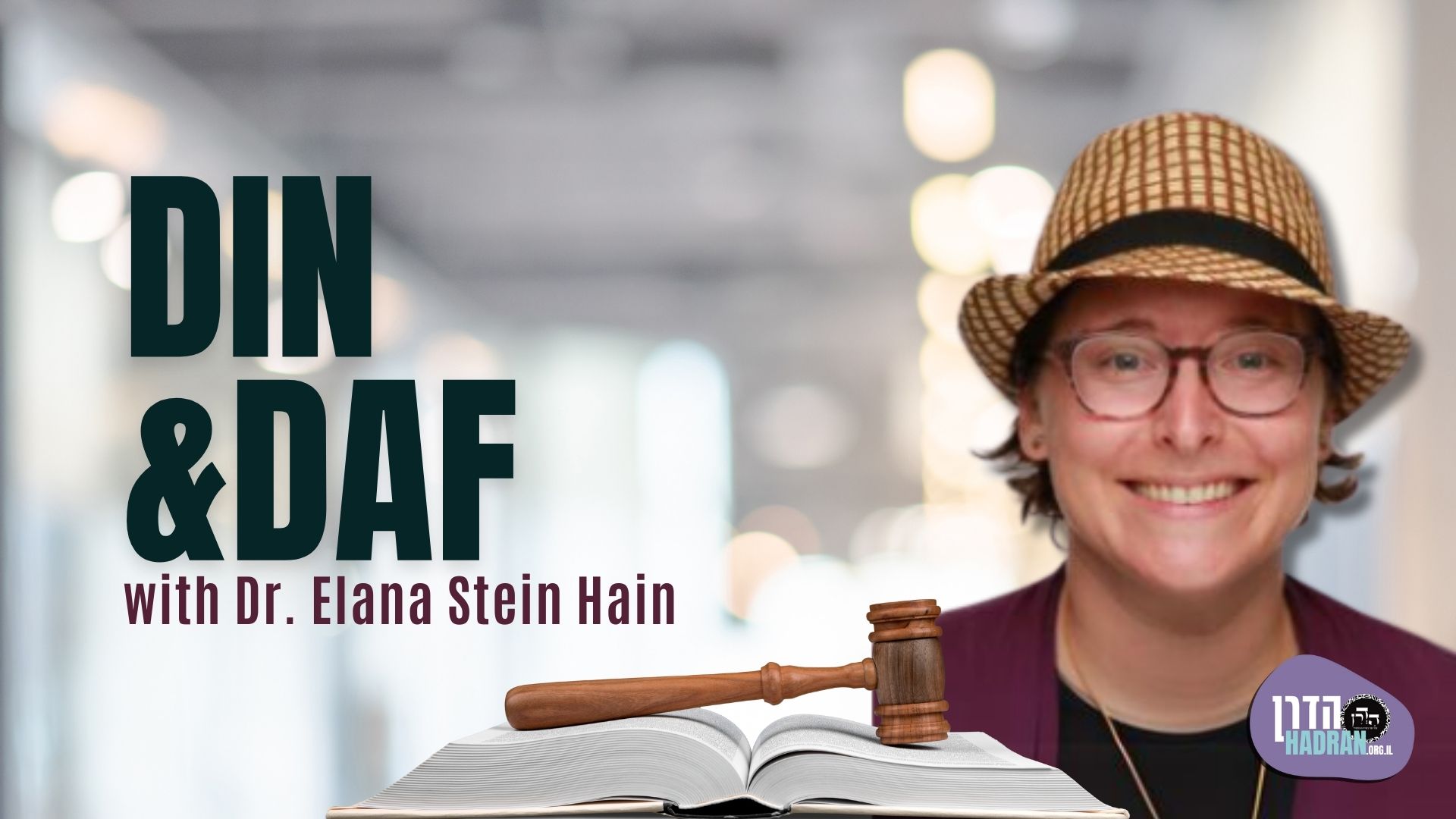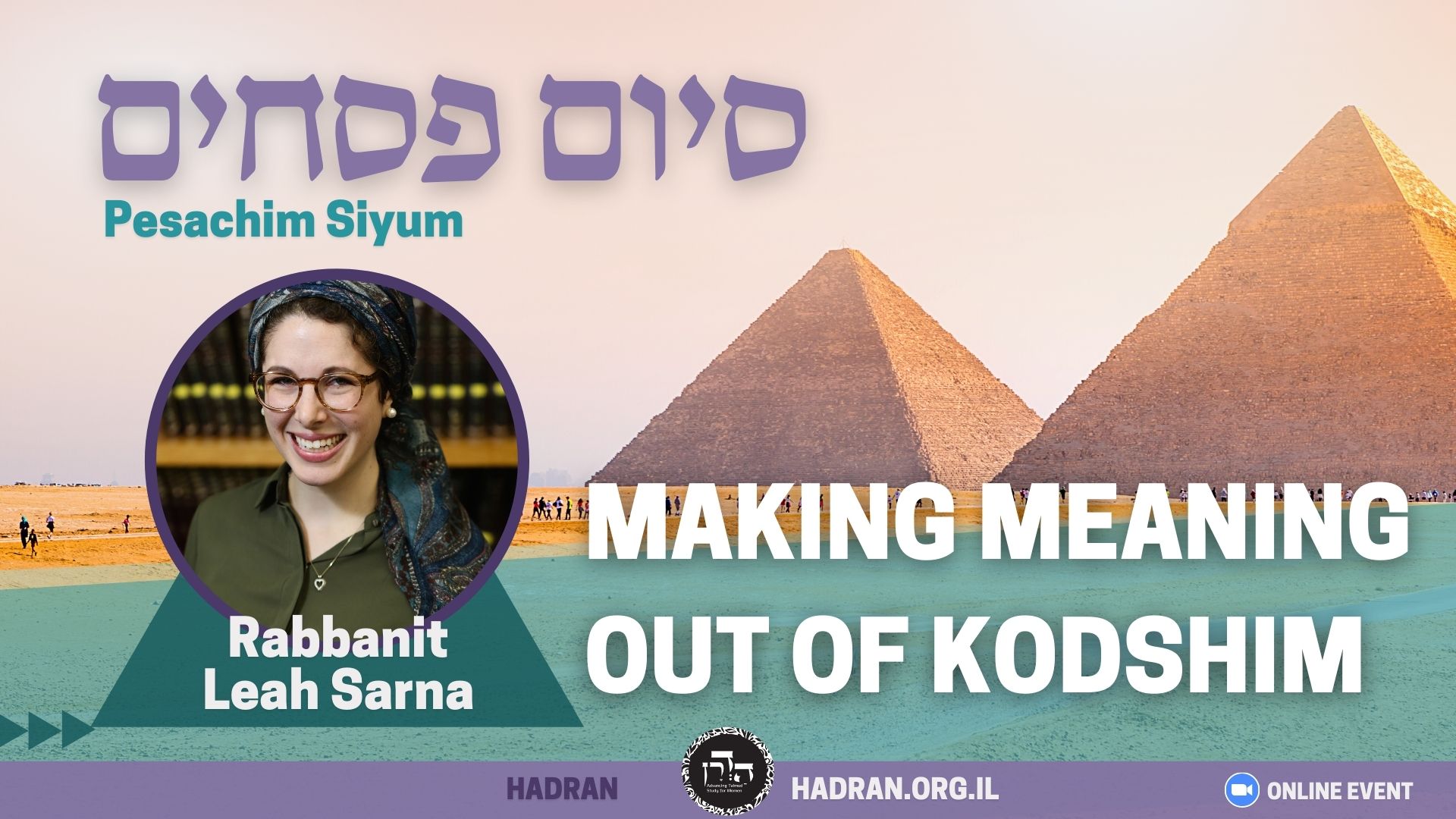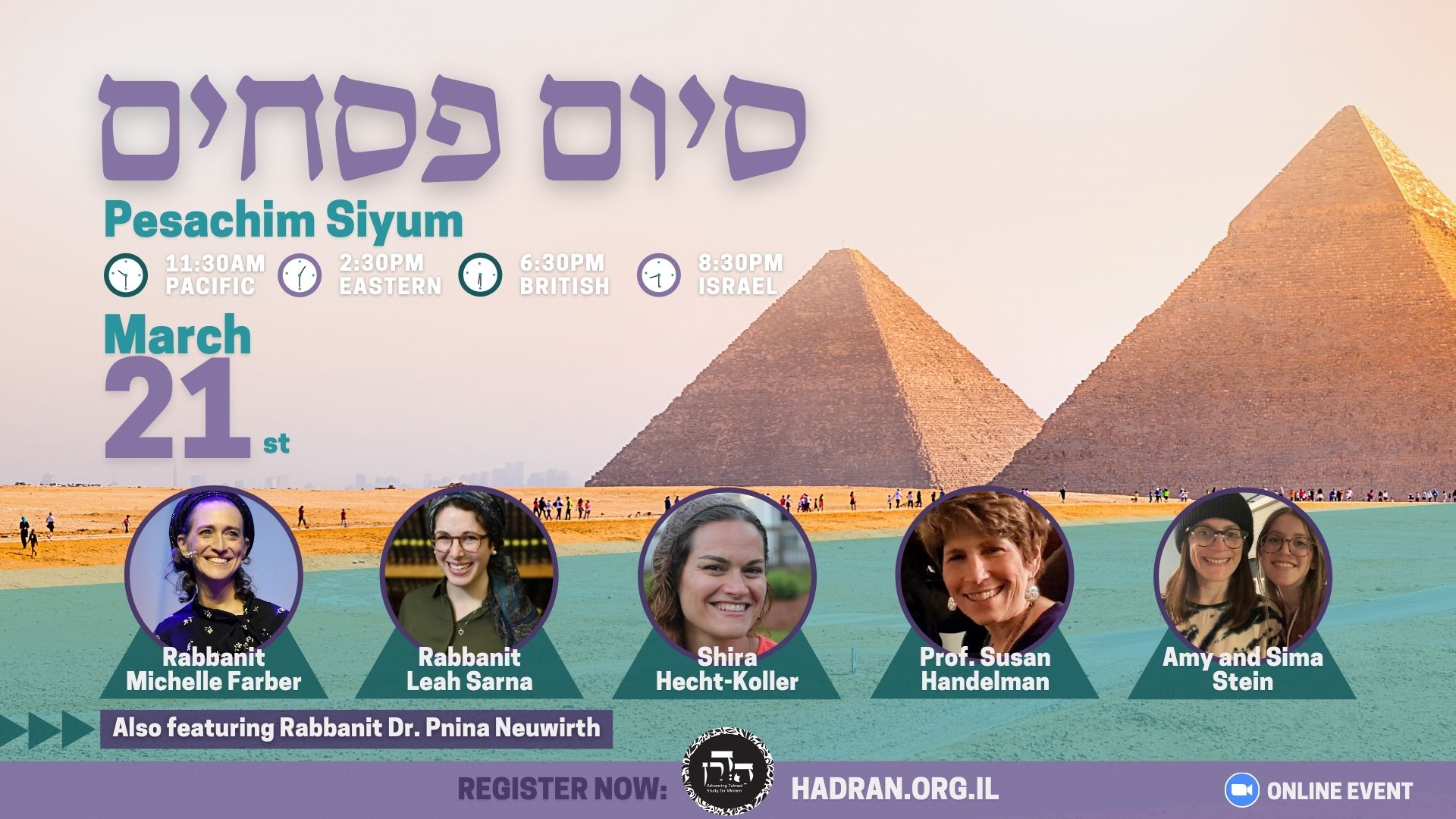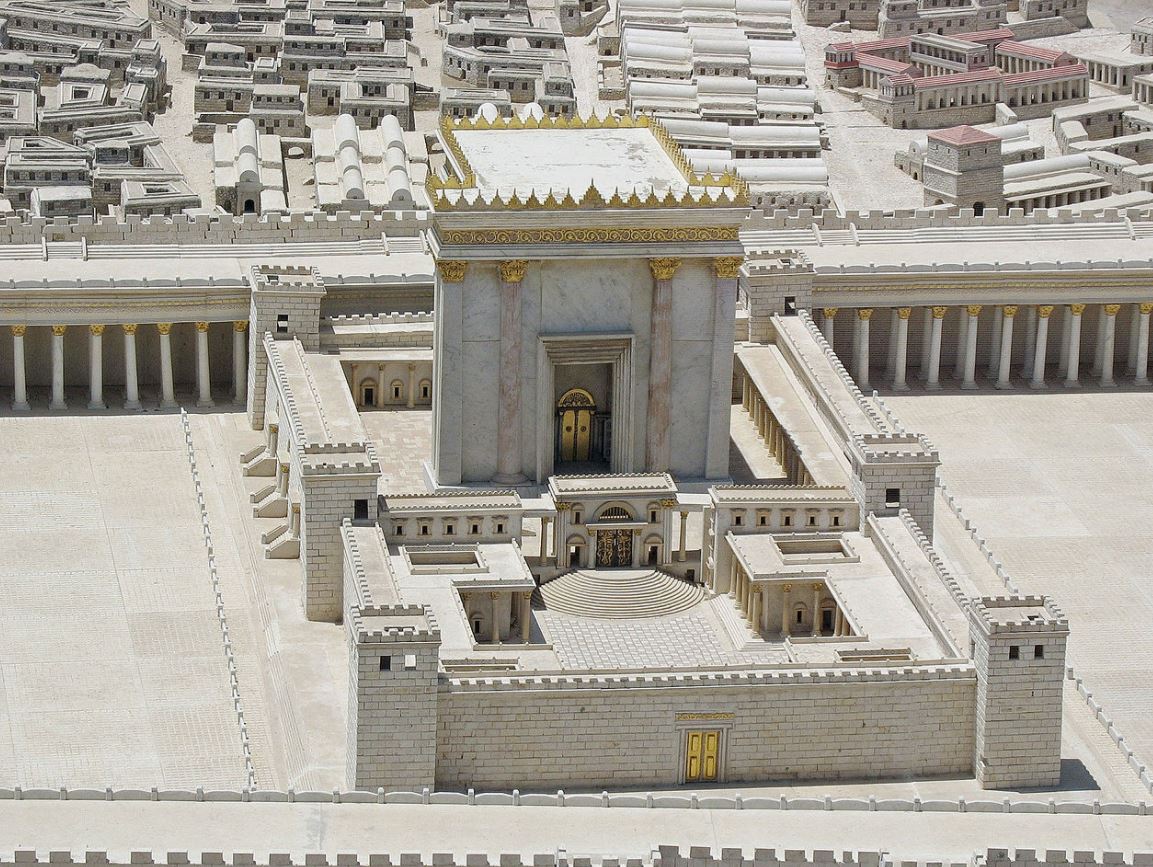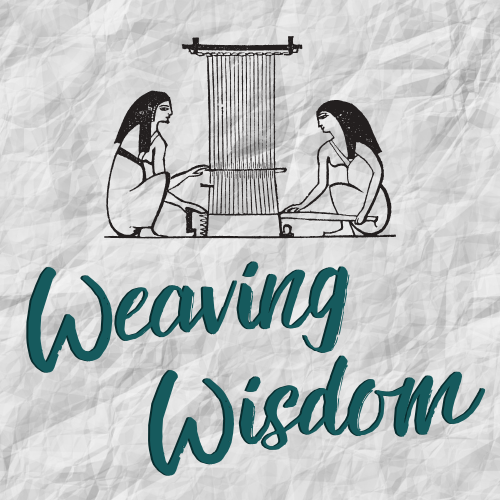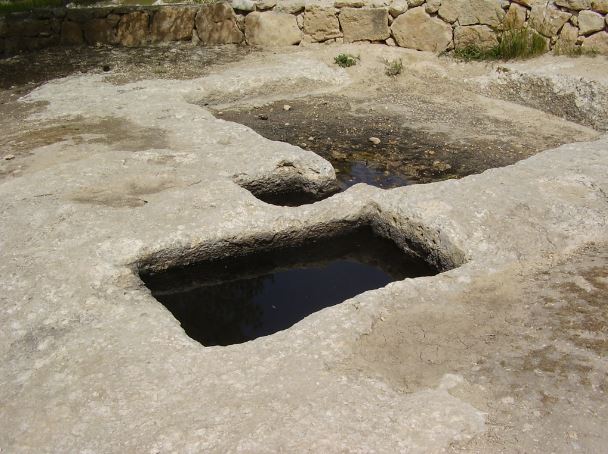Pesachim 94
לְרַב יְהוּדָה לָא קַשְׁיָא: טְמֵא שֶׁרֶץ רַחֲמָנָא דַּחְיֵיהּ, דִּכְתִיב: ״אִישׁ אִישׁ כִּי יִהְיֶה טָמֵא לָנֶפֶשׁ״, מִי לָא עָסְקִינַן שֶׁחָל שְׁבִיעִי שֶׁלּוֹ לִהְיוֹת בְּעֶרֶב הַפֶּסַח, וַאֲפִילּוּ הָכִי אָמַר רַחֲמָנָא — לִידְּחֵי.
According to Rav Yehuda’s opinion it is also not difficult, because in his opinion the Torah itself deferred the obligation of one who is ritually impure through contact with a dead creeping animal to the second Pesaḥ, as it is written: “If any man of you or of your generations shall be ritually impure due to a dead body” (Numbers 9:10). Are we not dealing even with a situation in which his seventh day of purification occurs on Passover eve, such that he can be ritually pure by nightfall and therefore he has the same status on that seventh day as one who became impure due to contact with a dead creeping animal? And nonetheless the Torah stated that his obligation shall be deferred. This teaches that anyone who is ritually impure at the time of the slaughtering has his obligation deferred to the second Pesaḥ, even if he would be able to immerse and become pure in time to eat the offering on the first Pesaḥ with the rest of the Jewish people.
תָּנוּ רַבָּנַן: הָיָה עוֹמֵד חוּץ לַמּוֹדִיעִים, וְיָכוֹל לִיכָּנֵס בְּסוּסִים וּבִפְרָדִים, יָכוֹל יְהֵא חַיָּיב — תַּלְמוּד לוֹמַר: ״וּבְדֶרֶךְ לֹא הָיָה״, וְהַלָּה הָיָה בַּדֶּרֶךְ.
The Sages taught: If one was standing outside the city of Modi’im and was able to enter Jerusalem on horses or mules but not by walking, I might have thought he would be liable to receive karet for failing to come to Jerusalem and offer the Paschal lamb; therefore, the verse states: “And is not on a journey” (Numbers 9:13). This person was on a distant journey and is therefore exempt.
הָיָה עוֹמֵד לִפְנִים מִן הַמּוֹדִיעִים, וְאֵין יָכוֹל לִיכָּנֵס מִפְּנֵי גְּמַלִּים וּקְרוֹנוֹת הַמְעַכְּבוֹת אוֹתוֹ, יָכוֹל לֹא יְהֵא חַיָּיב — תַּלְמוּד לוֹמַר: ״וּבְדֶרֶךְ לֹא הָיָה״, וַהֲרֵי לֹא הָיָה בַּדֶּרֶךְ.
On the other hand, if one was standing closer to Jerusalem than Modi’im but was not able to enter due to the camels and carriages that are carrying his family and delaying him, I might have thought he would not be liable for failing to offer the Paschal lamb because he is trying to enter; therefore, the verse states: “And was not on a journey,” and this person was not on a distant journey and is therefore liable. This person could have dismounted and come to Jerusalem on foot, but he wanted to bring his family with him in a carriage and was consequently delayed. One’s liability is determined based on his distance from Jerusalem.
אָמַר רָבָא: שִׁיתָּא אַלְפֵי פַּרְסֵי הָוֵי עָלְמָא, וְסוּמְכָא דִרְקִיעָא אַלְפָּא פַּרְסֵי. חֲדָא גְּמָרָא, וַחֲדָא סְבָרָא.
The discussion above pertaining to the distance that an average person can walk in a day is based on the assumption that he walks five mil between dawn and sunrise. The Gemara brings support for this assumption. Rava said: The size of the world is six thousand parasangs, and the thickness of the firmament is one thousand parasangs. One of these measurements with regard to the size of the world is a tradition, and one of the measurements is based upon Rava’s own reasoning.
סָבַר לַהּ כִּי הָא דְּאָמַר רַבָּה בַּר בַּר חָנָה אָמַר רַבִּי יוֹחָנָן: כַּמָּה מַהֲלַךְ אָדָם בֵּינוֹנִי בַּיּוֹם — עֶשֶׂר פַּרְסָאוֹת: מֵעֲלוֹת הַשַּׁחַר וְעַד הָנֵץ הַחַמָּה חֲמִשָּׁה מִילִין, מִשְּׁקִיעַת הַחַמָּה עַד צֵאת הַכּוֹכָבִים חֲמִשָּׁה מִילִין, נִמְצָא עוֹבְיוֹ שֶׁל רָקִיעַ אֶחָד מִשִּׁשָּׁה בַּיּוֹם.
The Gemara explains: Rava holds like that statement which Rabba bar bar Ḥana said that Rabbi Yoḥanan said: How far can an average person walk in a day? One can walk ten parasangs, which are forty mil. This is explained: From dawn until sunrise one can walk a distance of five mil; from sunset until the emergence of the stars one can walk another five mil. Therefore, it is found that the thickness of the firmament is one-sixth of the distance that the sun travels during the day. Between sunrise and sunset, the sun travels a distance of six thousand parasangs during the amount of time an average person can walk thirty mil. During the dawn and twilight periods in the morning and evening, when the sun passes through the thickness of the firmament, an average person can walk five mil, which is one-sixth of the distance he can walk between sunrise and sunset. Consequently, during dawn and twilight the sun must also travel one-sixth of the distance it travels between sunrise and sunset, i.e., one thousand parasangs, which is the thickness of the firmament.
מֵיתִיבִי, רַבִּי יְהוּדָה אוֹמֵר: עוֹבְיוֹ שֶׁל רָקִיעַ אֶחָד מֵעֲשָׂרָה בַּיּוֹם. תֵּדַע, כַּמָּה מַהֲלַךְ אָדָם בֵּינוֹנִי בַּיּוֹם — עֶשֶׂר פַּרְסָאוֹת, וּמֵעֲלוֹת הַשַּׁחַר עַד הָנֵץ הַחַמָּה אַרְבַּעַת מִילִין, מִשְּׁקִיעַת הַחַמָּה וְעַד צֵאת הַכּוֹכָבִים אַרְבַּעַת מִילִין, נִמְצֵאת עוֹבְיוֹ שֶׁל רָקִיעַ אֶחָד מֵעֲשָׂרָה בַּיּוֹם. תְּיוּבְתָּא דְרָבָא, תְּיוּבְתָּא דְעוּלָּא. תְּיוּבְתָּא.
The Gemara raises an objection from the following baraita: Rabbi Yehuda says: The thickness of the firmament is only one-tenth of the distance that the sun travels during the day. Know that this is true because how far can an average person walk in a day between dawn and the emergence of the stars? One can walk ten parasangs, which are forty mil, and from dawn until sunrise one can walk only four mil, which are one parasang. Therefore, it is found that the thickness of the firmament is only one-tenth of the distance that the sun travels during the day. This is a refutation of the opinion of Rava. Similarly, it is a refutation of the opinion of Ulla, who holds that an average person can walk fifteen mil in half a day, whereas Rabbi Yehuda holds that the average person can walk sixteen mil in half a day. The Gemara concludes: It is indeed a conclusive refutation.
לֵימָא תֶּיהְוֵי תְּיוּבְתָּא דְּרַבִּי יוֹחָנָן? אָמַר לָךְ: אֲנָא בִּימָמָא הוּא דַּאֲמַרִי, וְרַבָּנַן הוּא דְּקָא טָעוּ, דְּקָא חָשְׁבִן דְּקַדְמָא וַחֲשׁוֹכָא.
The Gemara suggests: Let us say that this will be a conclusive refutation of the opinion of Rabba bar bar Ḥana, citing Rabbi Yoḥanan, with regard to how far an average person can walk in a day. The Gemara answers: Rabbi Yoḥanan could have said to you: I am speaking about the total distance that an average person can walk in an entire day, but I never specified the distance one can walk during different parts of the day. And it was the Sages Ulla and Rava who erred in interpreting my opinion by saying that one can walk five mil and not four during each intermediate period, because when they calculated five mil before sunrise and after sunset they included the distance walked by people who set out earlier in the morning, before dawn, and by those who continued walking after nightfall.
לֵימָא תֶּיהְוֵי תְּיוּבְתָּא דְּרַבִּי חֲנִינָא? לָא, ״וַיָּאִיצוּ״ שָׁאנֵי.
The Gemara suggests: Let us say it is a conclusive refutation of the opinion of Rabbi Ḥanina, who proved from biblical verses that the distance from Sodom to Zoar is five mil. The angels and Lot walked that distance between dawn and sunrise, which implies that it is only four mil. The Gemara responds: No, that verse states: “The angels hastened Lot,” which indicates that they traveled very quickly. Therefore, hastened is different; because they hurried, they traveled five mil in the time one would normally walk four mil.
תָּא שְׁמַע: מִצְרַיִם הָיָה אַרְבַּע מֵאוֹת פַּרְסָה עַל אַרְבַּע מֵאוֹת פַּרְסָה, וּמִצְרַיִם אֶחָד מִשִּׁשִּׁים בְּכוּשׁ, וְכוּשׁ אֶחָד מִשִּׁשִּׁים בָּעוֹלָם, וְעוֹלָם אֶחָד מִשִּׁשִּׁים בַּגָּן, וְגַן אֶחָד מִשִּׁשִּׁים בְּעֵדֶן, וְעֵדֶן אֶחָד מִשִּׁשִּׁים בְּגֵיהִנָּם, נִמְצָא כׇּל הָעוֹלָם כּוּלּוֹ כְּכִיסּוּי קְדֵירָה לְגֵיהִנָּם. תְּיוּבְתָּא.
Come and hear a challenge from a baraita to the previous opinion with regard to the size of the world: The size of Egypt was four hundred parasangs by four hundred parasangs, and Egypt is one-sixtieth of the size of Cush, and Cush is one-sixtieth of the world, and the world is one-sixtieth the size of the Garden of Eden, and the Garden of Eden is one-sixtieth of Eden, and Eden is one sixtieth of the size of Gehenna. Therefore, it is found that the entire world is like a pot cover, which is a small part of the total size of the pot, compared to Gehenna. In any event, based upon the sizes of Egypt and Cush, it is apparent that the entire world is larger than six thousand parasangs. This is indeed a conclusive refutation.
תָּא שְׁמַע, דְּתָנָא דְּבֵי אֵלִיָּהוּ, רַבִּי נָתָן אוֹמֵר: כׇּל הַיִּשּׁוּב כּוּלּוֹ תַּחַת כּוֹכָב אֶחָד יוֹשֵׁב. תֵּדַע, שֶׁהֲרֵי אָדָם נוֹתֵן עֵינוֹ בְּכוֹכָב אֶחָד, הוֹלֵךְ לַמִּזְרָח — עוֹמֵד כְּנֶגְדּוֹ, לְאַרְבַּע רוּחוֹת הָעוֹלָם — עוֹמֵד כְּנֶגְדּוֹ, מִכְּלָל דְּכׇל הַיִּשּׁוּב כּוּלּוֹ תַּחַת כּוֹכָב אֶחָד יוֹשֵׁב. תְּיוּבְתָּא.
Come and hear another challenge: One of the Sages of the school of Eliyahu taught that Rabbi Natan says: The entire settlement, the area of the world that is inhabited, sits under one star. Know that this is correct because when a person focuses his eye on one star, he can travel east as far as he wishes within the settled part of the world and the star remains opposite him in the same place, and he can travel in the four directions of the world and the star remains in place opposite him. By inference, the entire settlement of the world rests under one star; and since so many stars are visible and each one covers an area of the world comparable in size to the entire settled portion of the world, it must be that the world is larger than six thousand parasangs. The Gemara comments that this is indeed a conclusive refutation of Rava’s opinion.
תָּא שְׁמַע: עֲגָלָה בַּצָּפוֹן, וְעַקְרָב בַּדָּרוֹם, וְכׇל הַיִּשּׁוּב כּוּלּוֹ אֵינוֹ יוֹשֵׁב אֶלָּא בֵּין עֲגָלָה לְעַקְרָב. וְכׇל הַיִּשּׁוּב כּוּלּוֹ אֵינוֹ הֹוֶה אֶלָּא שָׁעָה אַחַת בַּיּוֹם, שֶׁאֵין חַמָּה נִכְנֶסֶת לַיִּשּׁוּב אֶלָּא שָׁעָה אַחַת בַּיּוֹם.
Come and hear another challenge from another baraita, which teaches that the constellation Ursa Major is in the north and the constellation Scorpio is in the south, and the entire settlement sits between Ursa Major and Scorpio, as the relative positions of these two constellations appear to be the same from any location in the settled areas of the world. The ratio of the entire settlement to the world as a whole is comparable to only one hour in a day, as the sun enters the sky above the settlement for only one hour a day while the rest of the day it is outside the settlement.
תֵּדַע, שֶׁבְּחָמֵשׁ חַמָּה בַּמִּזְרָח, וּבְשֶׁבַע חַמָּה בַּמַּעֲרָב, חֲצִי שֵׁשׁ וַחֲצִי שֶׁבַע חַמָּה עוֹמֶדֶת בְּרֹאשׁ כׇּל אָדָם. תְּיוּבְתָּא.
Know that this is correct because at five hours into the day the sun is still in the east, and at seven hours the sun is in the west. During the second half of the sixth hour and the first half of the seventh hour the sun is positioned on top of everyone, as it is in the middle of the sky in every inhabited area during this time. Apparently, the sun travels over the inhabited parts of the world in a single hour while the rest of the day it travels over the uninhabited parts. Therefore, the entire settled portion of the world is equal to one-twelfth of the world. It was established that the settled part of the world itself is several parasangs, so the entire world must be larger than six thousand parasangs. This also serves as a conclusive refutation of Rava’s opinion.
תָּא שְׁמַע, דְּאָמַר רַבָּן יוֹחָנָן בֶּן זַכַּאי: מָה תְּשׁוּבָה הֱשִׁיבַתּוּ בַּת קוֹל לְאוֹתוֹ רָשָׁע בְּשָׁעָה שֶׁאָמַר ״אֶעֱלֶה עַל בָּמֳתֵי עָב אֶדַּמֶּה לְעֶלְיוֹן״, יָצְתָה בַּת קוֹל וְאָמְרָה לוֹ: רָשָׁע בֶּן רָשָׁע,
Come and hear another challenge, as Rabban Yoḥanan ben Zakkai said: What response did the Divine Voice answer to that wicked man, Nebuchadnezzar, when he said: “I will ascend above the heights of the clouds; I will be like the Most High” (Isaiah 14:14)? A Divine Voice emerged and said to him: Wicked man, son of a wicked man,
בֶּן בְּנוֹ שֶׁל נִמְרוֹד הָרָשָׁע, שֶׁהִמְרִיד אֶת כָּל הָעוֹלָם כּוּלּוֹ עָלַי בְּמַלְכוּתוֹ. כַּמָּה שְׁנוֹתָיו שֶׁל אָדָם? שִׁבְעִים שָׁנָה, וְאִם בִּגְבוּרוֹת — שְׁמוֹנִים שָׁנָה, שֶׁנֶּאֱמַר: ״יְמֵי שְׁנוֹתֵינוּ בָהֶם שִׁבְעִים שָׁנָה וְאִם בִּגְבוּרוֹת שְׁמוֹנִים שָׁנָה״,
the disciple in corruption of Nimrod the wicked, who caused the entire world to rebel against Me during his reign by advising the generation of the dispersion to build a tower in order to fight the Hosts of Heaven, how many are the years of a person altogether? Seventy years, and if he is with strength, eighty years, as it is stated: “The days of our years are seventy years and with strength eighty years” (Psalms 90:10).
מִן הָאָרֶץ עַד לָרָקִיעַ מַהֲלַךְ חֲמֵשׁ מֵאוֹת שָׁנָה, וְעוֹבְיוֹ שֶׁל רָקִיעַ מַהֲלַךְ חֲמֵשׁ מֵאוֹת שָׁנָה, וּבֵין (כׇּל) רָקִיעַ לְרָקִיעַ מַהֲלַךְ חֲמֵשׁ מֵאוֹת שָׁנָה, וְכֵן בֵּין כׇּל רָקִיעַ וְרָקִיעַ, ״אַךְ אֶל שְׁאוֹל תּוּרָד אֶל יַרְכְּתֵי בוֹר״. תְּיוּבְתָּא.
In contrast, from the earth to the first firmament of seven (see Ḥagiga 12b) is a walking distance of five hundred years, and the thickness of the firmament is a walking distance of five hundred years, which is equal to approximately 1.8 million parasangs, and between each firmament is another walking distance of five hundred years, and so too between each and every firmament. Therefore, how can you, Nebuchadnezzar, hope to reach the heavens in your lifetime, such that you say: “I will be like the Most High”? Rather, as the verse continues: “Yet you shall be brought down to the netherworld, to the uttermost parts of the pit” (Isaiah 14:15). In any event, this is a conclusive refutation of Rava’s opinion that the thickness of the firmament is only one thousand parasangs.
תָּנוּ רַבָּנַן, חַכְמֵי יִשְׂרָאֵל אוֹמְרִים: גַּלְגַּל קָבוּעַ, וּמַזָּלוֹת חוֹזְרִין. וְחַכְמֵי אוּמּוֹת הָעוֹלָם אוֹמְרִים: גַּלְגַּל חוֹזֵר, וּמַזָּלוֹת קְבוּעִין. אָמַר רַבִּי: תְּשׁוּבָה לְדִבְרֵיהֶם — מֵעוֹלָם לֹא מָצִינוּ עֲגָלָה בַּדָּרוֹם וְעַקְרָב בַּצָּפוֹן.
In a discussion related to the structure of the natural world, the Sages taught: The Jewish Sages say the celestial sphere of the zodiac is stationary, and the constellations revolve in their place within the sphere; and the sages of the nations of the world say the entire celestial sphere revolves, and the constellations are stationary within the sphere. Rabbi Yehuda HaNasi said: A refutation of their words that the entire sphere moves can be derived from the fact that we have never found the constellation of Ursa Major in the South or Scorpio in the North. This indicates that it is the stars themselves that revolve in place and not the celestial sphere as a whole, because otherwise it would be impossible for Ursa Major to remain in the North and Scorpio to remain in the South.
מַתְקֵיף לַהּ רַב אַחָא בַּר יַעֲקֹב: וְדִילְמָא כְּבוּצִינָא דְרִיחְיָא. אִי נָמֵי כְּצִינּוֹרָא דְּדַשָּׁא.
Rav Aḥa bar Ya’akov strongly objects to this proof: And perhaps the stars are stationary within the sphere like the steel socket of a mill, which remains stationary while the stones of the mill revolve around it. Alternatively, perhaps they are stationary like the pivot of a door, which remains stationary while the door makes wide turns around it; similarly, perhaps the constellations are stationary within a sphere, and there is an outer sphere within which the sun revolves around all the constellations. Therefore, Rabbi Yehuda HaNasi’s statement is not necessarily true.
חַכְמֵי יִשְׂרָאֵל אוֹמְרִים: בַּיּוֹם חַמָּה מְהַלֶּכֶת לְמַטָּה מִן הָרָקִיעַ, וּבַלַּיְלָה לְמַעְלָה מִן הָרָקִיעַ. וְחַכְמֵי אוּמּוֹת הָעוֹלָם אוֹמְרִים: בַּיּוֹם חַמָּה מְהַלֶּכֶת לְמַטָּה מִן הָרָקִיעַ, וּבַלַּיְלָה לְמַטָּה מִן הַקַּרְקַע. אָמַר רַבִּי: וְנִרְאִין דִּבְרֵיהֶן מִדְּבָרֵינוּ, שֶׁבַּיּוֹם מַעֲיָנוֹת צוֹנְנִין, וּבַלַּיְלָה רוֹתְחִין.
The Gemara presents a similar dispute: The Jewish Sages say that during the day the sun travels beneath the firmament and is therefore visible, and at night it travels above the firmament. And the sages of the nations of the world say that during the day the sun travels beneath the firmament, and at night it travels beneath the earth and around to the other side of the world. Rabbi Yehuda HaNasi said: And the statement of the sages of the nations of the world appears to be more accurate than our statement. A proof to this is that during the day, springs that originate deep in the ground are cold, and during the night they are hot compared to the air temperature, which supports the theory that these springs are warmed by the sun as it travels beneath the earth.
תַּנְיָא רַבִּי נָתָן אוֹמֵר: בִּימוֹת הַחַמָּה, חַמָּה מְהַלֶּכֶת בְּגוֹבַהּ שֶׁל רָקִיעַ, לְפִיכָךְ כָּל הָעוֹלָם כּוּלּוֹ רוֹתֵחַ וּמַעֲיָנוֹת צוֹנְנִין. בִּימוֹת הַגְּשָׁמִים, חַמָּה מְהַלֶּכֶת בְּשִׁיפּוּלֵי רָקִיעַ, לְפִיכָךְ כָּל הָעוֹלָם כּוּלּוֹ צוֹנֵן וּמַעֲיָנוֹת רוֹתְחִין.
It was taught in a baraita that Rabbi Natan says: During the summer the sun travels high in the sky, above the earth, and therefore the entire world is hot, and springs that originate deep in the ground are cold. On the other hand, during the winter the sun travels low in the sky, over the edges of the earth. Therefore, the entire world is cold, but springs are hot relative to the air temperature.
תָּנוּ רַבָּנַן: בְּאַרְבָּעָה שְׁבִילִין חַמָּה מְהַלֶּכֶת. נִיסָן אִיָּיר וְסִיוָן — מְהַלֶּכֶת בֶּהָרִים, כְּדֵי לְפַשֵּׁר אֶת הַשְּׁלָגִין. תַּמּוּז אָב וֶאֱלוּל — מְהַלֶּכֶת בַּיִּשּׁוּב, כְּדֵי לְבַשֵּׁל אֶת הַפֵּירוֹת. תִּשְׁרֵי מְרַחְשְׁוָן וְכִסְלֵיו — מְהַלֶּכֶת בַּיַּמִּים, כְּדֵי לְיַבֵּשׁ אֶת הַנְּהָרוֹת. טֵבֵת שְׁבָט וַאֲדָר — מְהַלֶּכֶת בַּמִּדְבָּר, שֶׁלֹּא לְיַבֵּשׁ אֶת הַזְּרָעִים.
The Sages taught: The sun travels in four paths during the four seasons of the year, and each causes a unique weather pattern: During the months of Nisan, Iyyar, and Sivan, the sun travels over the mountains in order to melt the snows that collected during the winter. During Tammuz, Av, and Elul, it travels over the areas of the settlement in order to ripen the produce. During Tishrei, Marḥeshvan, and Kislev, it travels over the seas in order to dry the rivers, as the rivers flow more gently during that time of year and the water turns into rain clouds. During Tevet, Shevat, and Adar, it travels over the desert in order to not dry the seeds that were planted in the inhabited areas of settlement, which begin to sprout during this time.
וְרַבִּי אֱלִיעֶזֶר אוֹמֵר מֵאִסְקוּפַּת כּוּ׳. וְאַף עַל גַּב דְּמָצֵי עָיֵיל, וְלָא אָמְרִינַן לֵיהּ קוּם עֱיֵיל?! וְהָתַנְיָא: יְהוּדִי עָרֵל שֶׁלֹּא מָל — עָנוּשׁ כָּרֵת, דִּבְרֵי רַבִּי אֱלִיעֶזֶר.
It was taught in the mishna that Rabbi Eliezer says: Anyone located from the threshold of the Temple courtyard and beyond is considered to be on a distant journey. The Gemara objects: And even though he is able to enter the courtyard, we do not say to him: Get up and enter; rather, we rely on the fact that at the critical moment he is outside the courtyard. But wasn’t it taught in a baraita: An adult uncircumcised Jew who did not circumcise himself will be punished with karet for being unable to eat the Paschal lamb on Passover; this is the statement of Rabbi Eliezer. Apparently, Rabbi Eliezer himself requires one to take action and circumcise himself so that the obligation to bring the Paschal lamb will apply to him. If one does not do so, he is considered to have intentionally refrained from eating the Paschal lamb and will receive karet. This baraita in which Rabbi Eliezer requires a person to be proactive seems to contradict the mishna in which Rabbi Eliezer permits a person to remain passive.
אָמַר אַבָּיֵי: דֶּרֶךְ רְחוֹקָה לַטָּהוֹר, וְאֵין דֶּרֶךְ רְחוֹקָה לַטָּמֵא.
Abaye said: The exemption from observing the first Pesaḥ granted to one on a distant journey was stated only for one who is ritually pure, and there is no exemption of a distant journey for one who is ritually impure or is unfit to offer the Paschal lamb for any other reason. One who is unfit to offer the sacrifice must take action to enable him to fulfill his obligation, and he is not included in the exemption of being on a distant journey. Conversely, the exemption does apply to people who are inherently fit to offer the sacrifice, and who are therefore not liable to karet if they do not enter the courtyard. There is no need to warn them to offer the Paschal lamb.
רָבָא אָמַר, תַּנָּאֵי הִיא. דְּתַנְיָא, רַבִּי אֱלִיעֶזֶר אוֹמֵר: נֶאֱמַר רִיחוּק מָקוֹם בַּפֶּסַח, וְנֶאֱמַר רִיחוּק מָקוֹם בַּמַּעֲשֵׂר. מָה לְהַלָּן חוּץ לַאֲכִילָתוֹ, אַף כָּאן חוּץ לַאֲכִילָתוֹ.
Rava said: It is a dispute between tanna’im as to Rabbi Eliezer’s true opinion, as it was taught in a baraita that Rabbi Eliezer says: The exemption of a distant journey is stated with regard to the Paschal lamb, and the exemption of a distant journey is stated with regard to the second tithe, as the verse states: “And if the way be too long for you, so that you are not able to carry it because the place is too far from you, which the Lord your God shall choose to set His name there” (Deuteronomy 14:24). Just as later in the Torah, with regard to the second tithe, the exemption applies only to someone located outside the area where it may be eaten, as the second tithe may be eaten only in Jerusalem, so too here, with regard to the Paschal lamb, the exemption of a distant journey applies only to one located outside the place in which it may be eaten, which is the entire city of Jerusalem. According to this opinion, anyone located in Jerusalem is included in the obligation to offer the Paschal lamb.
רַבִּי יוֹסֵי בַּר רַבִּי יְהוּדָה אוֹמֵר מִשּׁוּם רַבִּי אֱלִיעֶזֶר: חוּץ לַעֲשִׂיָּיתוֹ.
However, Rabbi Yosei bar Rabbi Yehuda says, citing Rabbi Eliezer: The exemption of a distant journey applies to anyone located outside the area where the offering of the Paschal lamb may be performed, which is the Temple courtyard.
כְּמַאן אָזְלָא הָא דְּאָמַר רַבִּי יִצְחָק בַּר רַב יוֹסֵף: בִּטְמֵאִים הַלֵּךְ אַחַר רוֹב הָעוֹמְדִין בָּעֲזָרָה. כְּמַאן — כְּרַבִּי יוֹסֵי בַּר רַבִּי יְהוּדָה שֶׁאָמַר מִשּׁוּם רַבִּי אֱלִיעֶזֶר.
The Gemara asks: In accordance with whose opinion is that which Rabbi Yitzḥak bar Rav Yosef said: In determining whether the majority of the community is ritually pure or ritually impure, follow the majority of those standing in the courtyard, and do not take into consideration people who are in Jerusalem but have not come to the courtyard. In accordance with whose opinion is it? It is in accordance with the opinion that Rabbi Yosei bar Rabbi Yehuda said, citing Rabbi Eliezer, which is as follows: Circumstances that can change the details of one’s obligation to offer the Paschal lamb, such as whether one is in a state of ritual impurity or whether he is on a distant journey, are determined based on whether or not one is within the Temple courtyard at the time of the slaughter.
אָמַר לוֹ רַבִּי יוֹסֵי: לְפִיכָךְ וְכוּ׳. תַּנְיָא, רַבִּי יוֹסֵי הַגְּלִילִי אוֹמֵר: ״דֶּרֶךְ״, שׁוֹמֵעַ אֲנִי מַהֲלַךְ שְׁנַיִם אוֹ שְׁלֹשָׁה יָמִים, כְּשֶׁהוּא אוֹמֵר ״וּבְדֶרֶךְ לֹא הָיָה״, מַגִּיד שֶׁמֵּאִסְקוּפַּת הָעֲזָרָה וְלַחוּץ קָרוּי דֶּרֶךְ.
It was taught in the mishna that Rabbi Yosei said to him: Therefore, there is a dot over the letter heh. It was taught in a baraita that Rabbi Yosei HaGelili says: If the verse had said simply: “A distant journey,” One would conclude from it that it means the distance of at least a two- or three-day walk. However, when it says later: “But the man who is ritually pure and is not on a journey” (Numbers 9:13) and does not specify a distant journey, it teaches that from the threshold of the courtyard and beyond is called a journey, and the exemption is not limited to one on a distant journey as the first verse seemed to imply.



